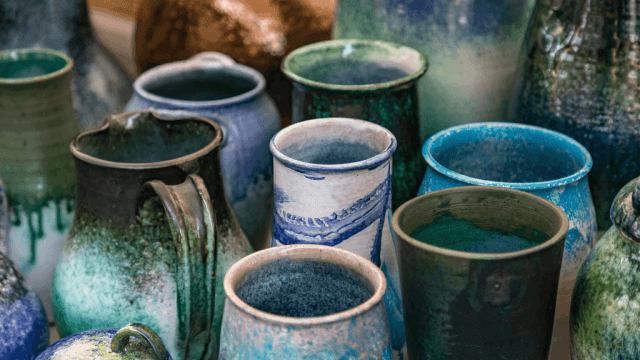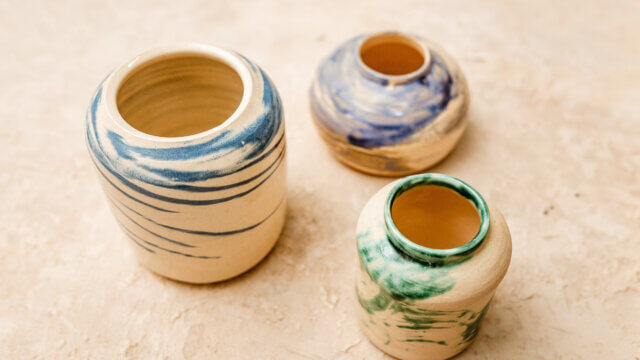To get into pottery, learn basic techniques through classes, workshops, or online resources. Gather essential tools like a pottery wheel, kiln, clay, and various shaping tools. Dedicate consistent time for practice, connect with the pottery community, and don’t be afraid to experiment with different styles and techniques.
Discover the Art of Pottery
Pottery is a versatile and creative art form that allows you to design and craft functional or decorative pieces. To get started in pottery, follow these steps:
1. Learn the Basics
Enroll in Classes or Workshops
Attend local pottery classes or workshops, where experienced instructors can guide you through the basic techniques and help you build a solid foundation.
Access Online Tutorials and Resources
If physical classes aren’t an option, explore online resources such as video tutorials, blogs, and forums that teach pottery techniques and offer tips and insights.
2. Gather Essential Tools and Materials
Pottery Wheel
Invest in a suitable pottery wheel for shaping and forming clay, with options ranging from manual wheels to electric-powered models with various features.
Kiln
Acquire a kiln for firing and hardening your pottery by purchasing one, renting kiln space, or joining a community studio with shared access.
Clay and Shaping Tools
Select appropriate clay types for your projects and stock up on essential shaping tools such as wire cutters, rib tools, needles, sponges, and trimming tools.
3. Practice and Refine Your Skills
Consistently practice pottery techniques, as regularly dedicating time to your craft can help you improve your skills and grow your confidence as an artist.
4. Connect with the Pottery Community
Join Local Pottery Groups or Clubs
Engage with fellow pottery enthusiasts to share experiences, tips, and encouragement, either in-person through local clubs or online via social media and pottery forums.
Attend Pottery Festivals and Exhibitions
Expand your knowledge and appreciation of pottery by visiting festivals and exhibitions where you can see the works of other artists, learn new techniques, and gather inspiration.
5. Experiment and Find Your Style
Explore various pottery techniques, styles, and materials to find your artistic voice and develop your unique approach to pottery. Don’t be afraid to take risks and break traditional conventions in your work.
6. Develop a Workspace
Having a designated pottery workspace can promote creativity and productivity by keeping tools and materials organized and accessible. Set up a corner of your home, a garage, or a shed for pottery work, ensuring that it has proper ventilation, ample lighting, and enough space for your equipment and projects.
7. Understand Pottery Safety
Learn how to safely handle materials, tools, and equipment to minimize potential hazards. Wear appropriate clothing and safety gear, maintain cleanliness in your workspace, and follow manufacturer’s guidelines when using machinery like kilns and pottery wheels.
8. Document Your Progress
Maintain a pottery journal or take photographs to document your progress, learn from your successes and setbacks, and track your artistic growth. Use these records to set goals for your pottery practice and to showcase your evolving skills and creativity to a wider audience.
9. Learn About Glazes and Finishes
Study and experiment with a variety of glazes, underglazes, and finishes to achieve different colors, textures, and effects on your pottery pieces. Familiarize yourself with mixing, applying, and firing these finishes and understand how chemical reactions during firing can impact the final result.
10. Sell and Showcase Your Work
Once you’ve honed your skills and developed a unique style, consider selling your pottery pieces or showcasing them in galleries, craft fairs, or online platforms. This can help you expand your reach, receive valuable feedback from customers and fellow artists, and potentially earn income from your pottery practice.
11. Continue Learning
Stay current on pottery trends, tools, and techniques by reading books, attending workshops, or taking advanced courses. Continually expanding your knowledge and skills will enable you to be more innovative in your work, while maintaining your passion and enthusiasm for the craft.
FAQ: Frequently Asked Questions
Here are some common questions and their answers to help guide you on your pottery journey:
What are the different types of clay used in pottery?
There are several types of clay suited for pottery, such as earthenware, stoneware, porcelain, and various blends containing grog or other additives. Each type has distinct properties, like workability, firing temperature, and strength, impacting its suitability for specific projects.
Do I need a pottery wheel to get started?
A pottery wheel is not essential for beginners. You can start by learning hand-building techniques such as pinching, coiling, and slab-building. Investing in a pottery wheel is beneficial once you become more serious about pottery and intend to explore wheel-throwing techniques.
How much does it cost to set up a home pottery studio?
The cost of setting up a home studio varies based on factors like equipment, materials, and space. Basic equipment like a pottery wheel and a kiln can range from $500 to $5000. Additional expenses include tools, clay, glazes, workspace setup, and electricity costs for firing the kiln.
How long does it take to learn pottery?
The time to learn pottery varies based on the individual, their learning style, and the techniques they want to master. While basic skills can be acquired in a few weeks or months, refining your expertise and developing a unique style may take years of practice, experimentation, and learning.
Can I fire pottery at home without a kiln?
While a kiln is the standard method to fire pottery, alternative techniques do exist. These include pit-firing, using a smaller and more portable raku kiln, or using a ceramic fiber blanket to create adequate insulation during firing. However, these techniques may have limitations in terms of temperature control, uniformity, and durability of the fired pottery.











